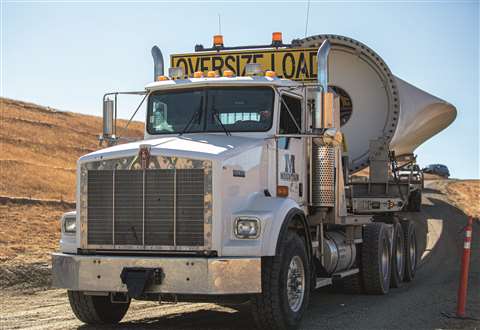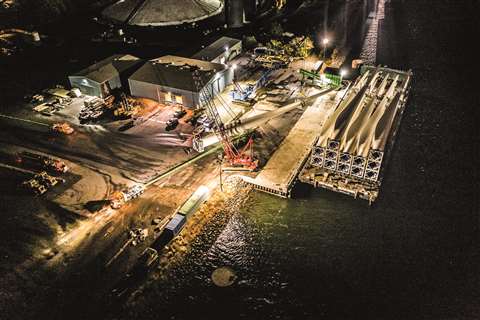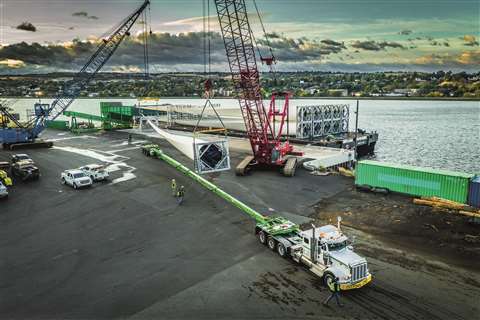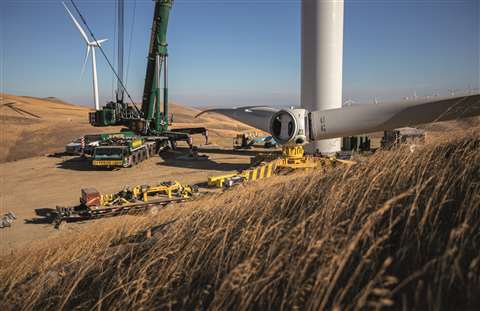Market for wind component transport trends up
01 July 2021
Transporting wind components is a steady business that requires expensive equipment and expert know-how.
Even though the Covid-19 pandemic halted or significantly slowed some sectors of the specialized transportation sector, the wind kept blowing, providing the fuel for the some 67,000 wind turbines installed in the United States as of January 2021.
 The market for transporting wind components is trending up for the companies that perform this specialty work.
The market for transporting wind components is trending up for the companies that perform this specialty work.
Omega Morgan’s Troy Tallent said the market for transporting wind components is trending up.
“I think after a crazy 2020 everyone has taken a breath, but we are still seeing activity and looking at projects across North America into 2024,” he said. “I believe everyone is still on pins and needles waiting to see how the new administration handles renewables. That being said, there has been a tremendous amount of public and private commitments to purchase and utilize green energy, and currently there is not enough out there to meet these commitments.”
Based in Portland, OR, Omega Morgan’s balance of wind transport business is about 80/20, new versus repower projects.
“Routes continue to be an issue both on and off the public roads,” said Tallent. “Efficiency in production for wind seems to go hand-in-hand with larger component sizes. Finding routes and ports that can accommodate these loads is definitely a challenge. Additionally, repower projects are trying to put new turbines on old sites.”
The civil spec that was utilized 15 years ago does not align with the increased size of components and associated equipment requirements today, Tallent explained.
But the bottom line is that Tallent believes “we will see continued growth in this market.”
On-site transport
Salt Lake City, UT-based Mountain Crane doesn’t do over-the-road wind component transport, but instead performs onsite transport work for wind contractors. With a full fleet of cranes suited for erecting wind turbines, Mountain Crane is a key player in the wind sector.
Director of Wind Travis Horton termed the over the road component market “flooded.”
“We have found good viability doing the hauling work onsite,” he said. “The blade lifters we have in the U.S. make it more financially feasible. As well, the market for onsite transport work is very limited because with the larger towers and turbines, you need a level of experience that not many companies have yet. We’ve gotten a head start getting with the right customers. We are ahead of the game.”
Most of Mountain Crane’s work is with new projects, although Horton said they have been getting inquiries about repower work in flat land areas due to reclaiming of the turn radiuses on the older sites.
The most challenging aspects of the onsite work Mountain Crane does is educating the customer regarding what is needed.
“Some customers think they can get away with a lot less and others think they have to do things a certain way,” he said. “Our challenge is to educate the market about what can and can’t be done.”
For example, hauling these delicate components in mountainous regions requires expensive equipment.
Horton said he expects the onsite wind component transport market to grow 20 to 30 percent over the current market.
“We are keeping our equipment 80 to 90 percent utilized,” he said. “I think things are lining up for more work by the end of the year.”
Because the company can supply cranes as well as haul components, Mountain Crane can offer a turn key job.
“It’s a full package that mitigates the customer’s risk,” he said. “If we are supplying the cranes, operators and transport, we are delivering to ourselves. This mitigates a lot of risk.”
“We are heavily invested in the wind market as compared to our competitors,” he said.
Mark Coyle of Supor Renewables concentrates on hauling offshore wind components in the Northeastern and Mid-Atlantic region of the U.S.
“We work with port logistics and marshalling yards to receive wind components from heavy lift ships,” said Supor Renewables’ Mark Coyle. “We will transport them to storage and then back to be loaded out on supply barges.”
Coyle also noted the most challenging aspects of this work is the cost of the equipment to haul the components and the sheer size and weight of the pieces. “But the most challenging part we see is the training required and keeping experienced labor through the end of the project,” he said.
 Omega Morgan crews offloaded the components from the barge and shuttled them to a laydown area.
Omega Morgan crews offloaded the components from the barge and shuttled them to a laydown area.
“When a roadblock gets in the way, or when schedules have customers in an impossible situation, our team rises to the challenge every time – even if that means innovating a brand-new solution to get the job done well and on schedule,” said COO Erik Zander.
A renewable energy company was facing one such challenge. They were already on a tight deadline to get wind turbine generator (WTG) components up to a wind farm in Alberta, Canada.
The problem was that there were multiple wind projects taking place simultaneously and along the same route. This would mean massive trucking delays and a guarantee of missing the scheduled deadline.
Schedule is everything in the transportation industry.
“Our Portland-based specialized transportation services crew and crane services crew all stepped up, in partnership with several other transportation and logistics companies, to help create a unique solution,” Zander said. “If trucking would cause massive delays, then we would need to bypass that route entirely.”
Omega Morgan proposed an alternative method for transportation: barging the WTG components to the Port of Lewiston in Lewiston, ID (avoiding trucking on the heavily-congested Oregon and Washington routes) and then trucking them to their final destination in Alberta.

This meant developing an entirely new means of transportation for components coming into the Pacific Northwest, Zander said.
It was a massive coordination effort, involving scheduling and communicating with all of the parties involved.
“Since shipments were coming into the Port of Lewiston from both the Port of Longview and the Port of Vancouver in Washington, our crews secured and provided suitable equipment to transport, offload and store the components from the lower Columbia River to the Port of Lewiston,” he said. “All in all, there were 12 voyages that headed upriver, and our crews prepared and adhered to all 12 of the barge stow and lashing plans.”
After the components had made their way up the river to the Port of Lewiston, Omega Morgan crews offloaded the components from the barge and shuttled them to a laydown area. Its crane services team used two crawler cranes to offload the WTG components and two crawler cranes to offload and stage the components at the wind distribution center, as well as load out the trucks.
A project of this scale and complexity would normally take three to four months to plan.
“Our client did not have that time, so the Omega Morgan team got a solid plan together for the safe transportation of these components in just five weeks,” said Zander. “Overall, this project required a massive amount of dedicated engineering time – over 250 hours’ worth – to complete.”
This was the first project of its kind in the Pacific Northwest.
Mountain Crane recently offloaded and erected 23 wind towers in a mountainous terrain. The 2.5-MW GE systems included 90-meter towers with 116-meter rotors.

“We transloaded the WTG components from the laydown yard and transported them using specialized equipment to the difficult-to-reach pads.
The blades measured 56.9 meters at a diameter of 2.4 meters. They weighed 11,432 kilograms. The base sections were 23.342 meters with a diameter of 4.556 meters. They weighed 60,779 kilograms. The mid sections were 31.6 meters and 4.3 meters in diameter. They weighed 52,531 kilograms.
In total there were 55 loads that were loaded out on 24 axles lines of Goldhofer THP, a Goldhofer with a six-meter spacer deck, a Goldhofer STZ5 and three Prime movers.
Low utility lines were a constant challenge, according to Mountain Crane’s Louie Bello.
We used dedicated trained crew to handle lifting utilities,” Bello said. “There were steep grades and hairpin turns while on a stee grade. This required assistance from a second prime mover to climb the steeper grades.”
Using specialized equipment created a cost savings by minimizing civil work, Bello said. “Specialized equipment could manage terrain up to 5 degrees laterally,” he said.
STAY CONNECTED


Receive the information you need when you need it through our world-leading magazines, newsletters and daily briefings.




